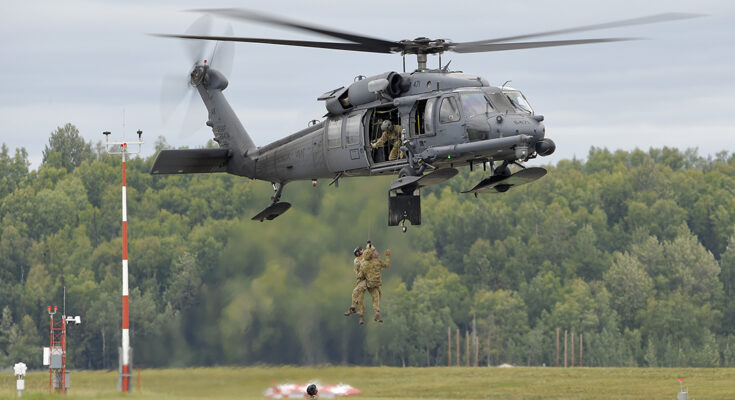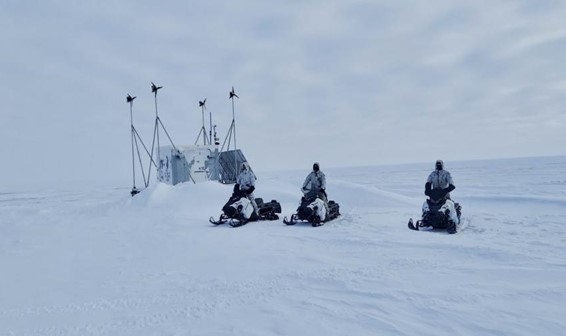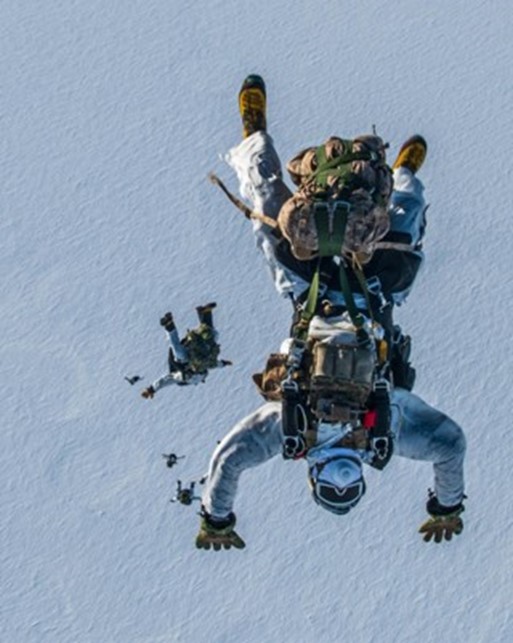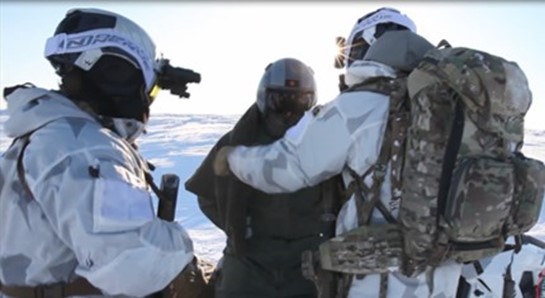
THE WATCH STAFF
The mission of Arctic search and rescue at its most basic is saving lives.
But when the United States military trains for combat search and rescue and personnel recovery (SAR/PR) with allies, it also strengthens operational capabilities.
“The ability to operate and succeed given the … harsh Arctic operating environment forever complicates any rescue, which is why it is so very important to exercise and reinforce rescue skill sets and capability,” said U.S. Air Force Col. Joseph Alkire III, deputy commander of the 611th Air Operations Center based at Alaska’s Joint Base Elmendorf-Richardson (JBER).
Alkire’s comments came in a January 2021 news release after the 176th Wing from the Alaska Air National Guard (AKANG) participated in SAR/PR exercise during Operation Noble Defender, an annual North American Aerospace Defense Command (NORAD) and U.S. Northern Command (USNORTHCOM) exercise. The wing’s Guardsmen are detailed full time to the regular Air Force’s 11th Air Force.
To reinforce the “rescue skill sets and capability” that Alkire mentioned, the U.S. and its allies continually train — from Alaska to Greenland — in Arctic SAR/PR through joint operations such as Operation Noble Defender (NORAD and USNORTHCOM), Dynamic Mercy (NATO), and Exercise Argus (Danish Defence). These collaborations help NORAD and USNORTHCOM build a Globally Integrated Layered Defense (GILD) and are integral in enhancing domain awareness and operational capacity to support the defense of North America.

These photos taken during exercise Arctic Edge 2022 illustrate some of the steps in Arctic search and rescue (SAR). From locate — U.S. Army Special Operations Forces on snowmobiles — to a free-fall infiltration technique used by Naval Special Warfare operators — to recovery. ALEXZANDRIA GOMEZ/U.S. ARMY
The U.S. military’s joint doctrine defines five steps for personnel recovery: report, locate, support, recover and reintegrate. SAR/PR training rehearses all of those steps, including medical care and even humanitarian-assistance missions.
To borrow a sports aphorism, the U.S. armed services “practice like they play” when it comes to SAR/PR exercises with allies and partners. U.S. SAR/PR response is available to any nation that requires assistance in the Arctic region.
“A lot of the folks that are up here now [off Greenland for Exercise Argus 2022] would be the same people that could potentially be deployed for a real-life event,” U.S. Coast Guard Cmd. Daniel Schrader said in a July 20, 2022, story by the website Arctic Today. “Making those connections and working alongside everyone now — it’s a lot easier if we have to come back [for an emergency].”
SAR/PR responders from Denmark, France and Greenland, as well as the U.S. Coast Guard cutter Oak, participated in Argus. Those partnerships not only build the foundation for saving lives, but also are part of a globally integrated layered defense that helps counter common threats.
Although U.S. Arctic territory is on the region’s Pacific side, the Atlantic side is also a priority for both strategic and commercial reasons, according to Arctic Today.
“All the other Arctic nations, except for Russia,” Schrader said, “have territory on the Atlantic side, so being able to coordinate with all of them is key to any success we have.”
That coordination also gives the U.S. and its allies an advantage over a strategic competitor such as Russia, especially in the wake of Moscow’s 2022 invasion of Ukraine. The action caused Arctic Council (AC) members Canada, Denmark, Finland, Iceland, Norway, Sweden and the United States to suspend their work. At the time, AC member Russia held the body’s rotating chairmanship.

Even with the pause, the USCG continued emergency cooperation with Russia in the Bering Strait, according to a March 2022 Reuters story. “But other partnerships with Russian counterparts have been put on hold, while collaboration with other Arctic nations has gained force, particularly as Sweden and Finland work to join the North Atlantic Treaty Organization,” Reuters said.
NATO’s SAR/PR exercise, Dynamic Mercy, is also held in the Atlantic region — including the Norwegian Sea — under the auspices of its Allied Maritime Command. Dynamic Mercy is designed to evaluate and improve SAR collaboration and communication with members and partners. Besides the U.S., 2022 participants included Belgium, Denmark, Faroe Islands, France, Germany, Iceland, Netherlands, Norway and the U.K.
The ‘tyranny of distance’
In 2011, the eight Arctic States signed the Agreement on Cooperation on Aeronautical and Maritime Search and Rescue in the Arctic. This accord defines the Arctic area in which each has the lead responsibility. In the Alaskan Arctic, that task falls on AKANG and the U.S. Coast Guard.
The region stretches 650 miles in width from the Bering Strait to the Canadian border (roughly the width of Texas) and extends 1,350 miles from the Brooks Range in the south to the North Pole (roughly equivalent to the distance from the southern tip of Texas to the northern border of North Dakota), according to a 2017 analysis published by the Pardee Rand Graduate School.
Alkire calls that the “tyranny of distance.”

“In the Arctic, time and distance are the greatest enemies,” the commandant of the Canadian Forces School of Survival and Aeromedical Training, Maj. Brian Noel, said during a 2021 Arctic SAR/PR seminar, according to a news release from Canadian NORAD Region. “Those hours that are spent transiting to a location are the difference between life and death.” To cover these distances in the search for Isolated Persons, PR forces employ various methods of infiltration — including Military Free Fall and long-range movements and navigation over harsh frozen tundra.
Such distances are hurdles that the region’s primary responders, AKANG and the USCG, must overcome. The closest USCG air station to Utqiagvik, the largest community in the Alaskan Arctic, is in Kodiak, some 820 nautical miles to the south. That’s nearly the same distance as from Boston to Miami, according to a March 24, 2022, Congressional Research Service report.
For maritime operations, the distance from the closest deep-water port (Dutch Harbor) to Utqiagvik is even greater, according to the Rand analysis. Responders must contend with mountainous terrain, rough seas, extreme cold, ice and spotty communications infrastructure.
Compounding such challenges, the Arctic’s melting sea ice is opening the region to increased maritime traffic, which also is forecast to increase SAR/PR operations involving both civilians and the military.
“Rescue is a key element,” Alkire said in the news release, “in sustaining the morale, cohesion and fighting capability of friendly forces.”
